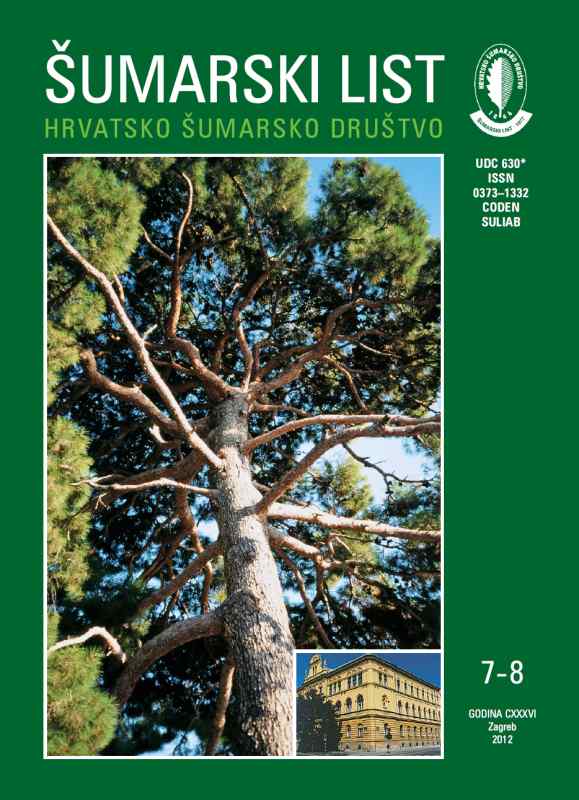
broj: 7-8/2012
pdf (5,5 MB) |
|
||||||||||||||
| RIJEČ UREDNIŠTVA | ||
| Uredništvo | ||
| SOMETHING ABOUT RESTRUCTURING pdf HR EN | 329 | |
| IZVORNI ZNANSTVENI ČLANCI | ||
| Krunoslav Teslak, Jura Čavlović, Mario Božić | UDK 630*624+653 (Pedunculate oak) (001) | |
| The even-aged forest development computer program SIMPLAG: design, structure and application pdf HR EN | 331 | |
|
SUMMARY Forest management planning in many cases is based on predicting of the development and future state of forest resources. A numerous stand development and forest development models are used as a support in forest management. During the last two decades the development and use of simulation models aimed to design of an integrated computer application as useful support for managing not only the forest but the natural resources in general. This paper presents the architecture of the computer program SIMPLAG, for simulation of development of an even-aged forest, particularly of pedunculate oak forests with an irregular structure (age class distribution, understocked old stands). The main components of the program are stand structure development models, the module for planning of stand regeneration (spatial and temporal) and the algorithm for the creation of the management scenarios. Development of the program was aimed to achieve: simulations of the pedunculate oak forest development based on the different management scenarios, and possibility of choosing of an appropriate management options which could lead to improving of the forest and stand structure in a long term. Built-in stand development models are based on available theoretical models for the pedunculate oak, and on reducing the number of trees due to mortality. According to a separate development models, development structure of the old stands up to time of regeneration (reduction of oak trees due to mortality, thinning and the formation of secondary stand to preserve soil), and development of newly regenerated stands (denser, mixed stands and thus more stable), are projected. There are separate structure development models for four tree species: pedunculate oak (Quercus robur L.), narrow-leaved ash (Fraxinus angustyfolia), hornbeam (Carpinus betulus L.) and "other broad-leaved trees". Ranking and selection of stands or a part of stands according to regeneration priority are based on the economic criterion. The criterion means difference in potential revenue as a result of decision: prompt stand regeneration or adjournment of stand regeneration for 20 years. Habitat characteristics, structural and economic features of the stand are included too (Cavlovic et al. 2011a). As a base for a rough selection of part of stand for regeneration, the program uses inventory data (0.09 ha circular sample plots on network 100 * 100 m, each sample plot represent 1 ha of the stand). Calculation of the potential revenues during the projection period is based on the obtained relevant models of assortment structure and the prices of wood assortments, which are integrated in the program. Through a complex algorithm within the guidelines for the creating scenarios of future forest management (the maximum 10-year regeneration area, minimum and maximum area of the stand for regeneration, the minimum age of stands considered for regeneration, the minimum distance between regenerated stands), allows the numerous projections of the spatial and temporal forest development. Each step of the projection is showed on an interactive map that can display information for each 1 ha area or stand (group of 1 ha areas) separately (Figure 3, Figure 5). The basis of the spatial view is ESRI shape file that is required to set before creating the simulation. Plotting the spatial view is created by using GDI + programming instructions. The program is fully developed on .NET Framework 3.5 platform, using development tools Visual Studio 2008 and MS Access 2007 database. Used development language is C#. The SIMPLAG program provides information’s of the spatial and temporal forest development, development of age class distribution, stand development, amount and value of the revenues generated for each step of the projection, according to the different management scenarios. This information’s allow a comprehensive evaluation of a different management scenarios and selection of the most suitable management options. Key words: Pedunculate oak; projection of stand development; stand regeneration; management planning; selection of management scenarios | ||
| Milan Pernek, Sanja Novak Agbaba, Nikola Lacković, Nikolina Đođ, Ivan Lukić, Stefan Wirth | UDK 630* 165 (001) | |
| The role of biotic factors on pine (Pinus spp.) decline in north Dalmatia pdf HR EN | 343 | |
| Damir Drvodelić, Milan Oršanić, Zoran Zeman | UDK 630*233+232.3 (Pyrus pyraster Burgsd.) (001) | |
| Field performance after reforestation with one year old non-transplanted (1+0) and transplanted (1+1) seedlings of wild pear (Pyrus pyraster Burgsd.) pdf HR EN | 355 | |
| Dinka Matošević, George Melika | UDK 630*442 (001) | |
| Diversity of parasitoid assemblages of native and alien leaf miners in Croatia pdf HR EN | 367 | |
| STRUČNI ČLANCI | ||
| Marija Nodilo | UDK 630*165+907 | |
| Natural heritage of the island of Mljet – the basis of the development of the medical tourism pdf HR EN | 377 | |


